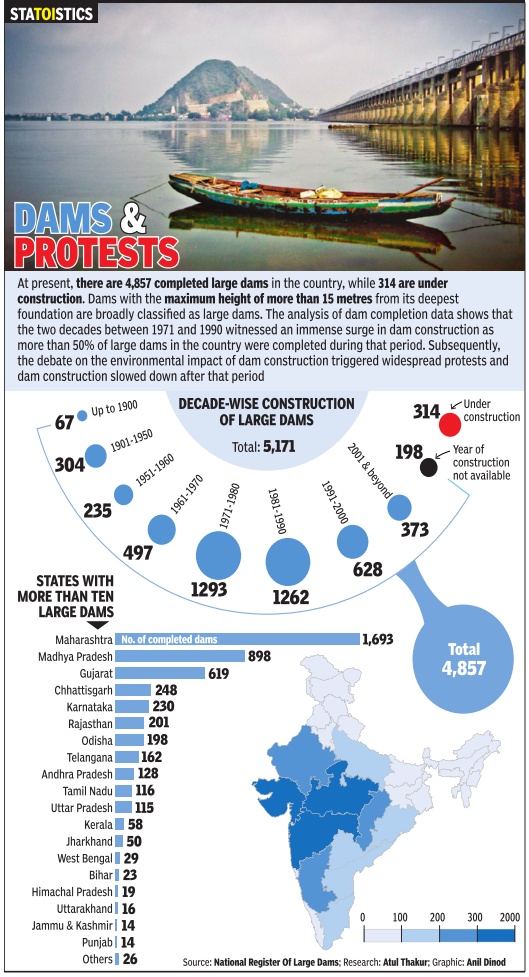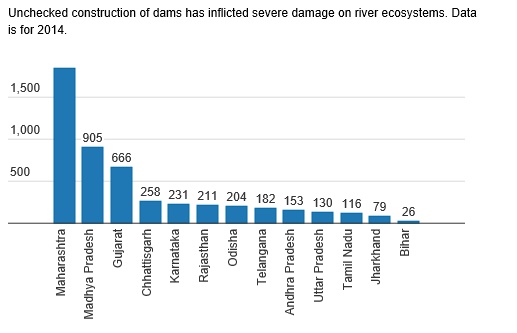Dams, reservoirs, hydro-electric projects: India
This is a collection of articles archived for the excellence of their content. |
Contents |
Construction, 1900-2014
See graphic:
Decade-wise construction of large dams (Hydro-electric projects): 1900-2014, and their statewise distribution
Unchecked construction of dams in India, as in 2014


Ageing and safety issues
`Break analysis' of 5,247 large dams: 2017

196 Of Them Are Over 100 Years Old
For the first time, the Centre is planning to conduct a `break analysis' of 5,247 large dams across the country , and put in place an emergency action plan, especially for the 196 that are over 100 years old. Of these 196 dams, 72 are in the southern states and Maharashtra.
Break analysis is the examination of dams to identify potential failures that may result in an uncontrolled release of water. It involves the characterisation of threats to public safety that a dam poses.
The government has already drafted a `dam safety bill', currently being reworked by the Niti Aayog.
There are two safety issues: the risk of breach and floods, and the decreasing ability to hold as much water as the original capacity (which means less live storage and per capita availability of water). These concerns make maintenance more critical for dams, though not all are in a dilapidated condition or in need of immediate repair.
In October 1987, the Centre had constituted the National Committee on Dam Safety (NCDS), which was tasked with overseeing dam safety and suggesting improvements. The committee, headed by the Central Water Commission chairman, met 37 times and has been instrumental in the maintenance of dams.
Dam expert Captain S Raja Rao, who was secretary of the Karnataka water resources department, said: “The safety aspect, especially with dams in flood-prone areas, is critical. Take the Alamatti dam (in Karnataka), and you'll see its size was increased based on advice from the World Bank, but it has several drawbacks.“
However, he pointed out that successive governments had been spending a lot of time and money on dam upkeep.“There is a continuous effort to improve the inspection galleries in dams (which are key indicators of a dam's health) and a project called DRIP (Dam Rehabilitation and Improvement Programme) is under way ,“ Rao said.
DRIP , which was started under the UPA government in April 2012 and has been working with five state governments (Karnataka, Tamil Nadu, Kerala, Madhya Pradesh and Odisha) and two agencies (Damodar Valley Corporation in Jharkhand and Uttarakhand Jal Vidyut Nigam Ltd), was conceived with an estimated budget of Rs 2,100 crore.The project cost has now been revised to around Rs 3,400 crore and the World Bank has agreed to fund 80% of that, DRIP director Pramod Narayan told TOI.
“While the goal is to eventually work on all dams in the country , we are working on 225 dams, and these don't include all the 196 dams that are more than 100 years old. For the first time, last month, we prepared a draft emergency action plan, which deals with situations that (could) arise in case of a breach, areas affected, rehabilitation, and so on,“ Narayan said.
One big problem, Rao said, was the fact that the majority of India's large dams had dysfunctional scouring-sluices (which are responsible to keep silt out of the dams), affecting storage capacity and posing a threat to the structure.
The Tungabhadra dam in Karnataka is just 64 years old, and more than 37% of it is filled with silt. In June, the government conceded on the floor of the state assembly that it is impossible to remove more than 0.11% of the silt. “Older dams have a larger problem of silt,“ Rao said, while Narayan added that continuous monitoring and regular intervention alone can prevent this problem from worsening.
Bhakra-Nangal Dam
Asit Jolly , Water walls “India Today” 21/8/2017
Among India's earliest river valley development projects, the Bhakra-Nangal multi-purpose dams were crucial to the success of the Green Revolution in the northern states of Punjab, Haryana and Rajasthan. Water from the dams brought irrigation to 135 lakh acres in the three states, besides preventing floods. At Independence, close to 80 per cent of the cultivable, canal-irrigated area of erstwhile Punjab fell in West Punjab and consequently went to Pakistan. This left the eastern or Indian portion of Punjab with scanty irrigation resources. Although envisaged even before Independence, preliminary earthwork on the Bhakra dam only started in 1948. Prime Minister Jawaharlal Nehru inaugurated the construction on November 18, 1955, pouring the first pail of concrete into what was to be the firm foundation of the dam. He called it a symbol of "nation's will to march forward with strength, determination and courage", despite the "great shock" and "grievous wound" suffered by Punjab. On completion, the Bhakra-a concrete gravity dam-was one of the highest in the world at 741 feet, just three feet short of the US's then tallest Hoover dam. At its inauguration on October 22, 1963, Nehru said, "Call it a temple, a gurdwara or a mosque, it inspires our administration and reverence." Other stages of the project, including a downstream dam at Nangal, were completed by the early 1970s. Back then, the Bhakra-Nangal project was the only one in Asia capable of achieving generation capacities of 1,500 megawatts.
Today, the dams are part of the Bhakra Beas Management Board (BBMB), which is critical to the operation of the northern electricity grid. The BBMB powerhouse, including Bhakra-Nangal, generates between 1,900 MW and 2,800 MW in the summer months, and 500 MW to 1,900 MW in winters. The hydroelectric projects allow for thermal power stations in the region to operate at base levels. The Bhakra-Nangal and Beas projects, which annually supply 28 million acre feet (MAF) of water, have hugely contributed to the continuing success of the Green Revolution as well as the massive increase in milk production in the northern states.